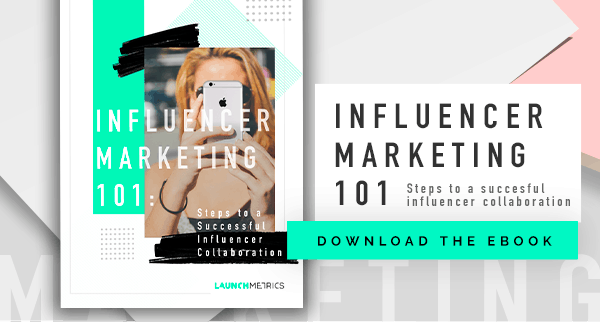Influencer marketing, the buzziest term in the industry right now, allows brands to build relationships with trusted figures in their community and utilize their platform to help boost brand awareness, ignite brand interests, and encourage a purchase. While it sounds enticing to find an influencer with a massive following to help promote your brand, your campaign goals may not be achieved by merely partnering with celebrity-status influencers.
Knowing this, brands need to have a deep understanding of how to engage influencers and learn how to seamlessly integrate their influencer engagement strategy with their current marketing and PR objectives. Finding the right influencer for your next campaign can be extremely complex and tedious, but to help brands better navigate through this, Launchmetrics has developed a guide, Influencer Marketing 101: Steps to a Successful Influencer Collaboration, in which you’ll find the best practices for managing both your influencer engagement strategy and relationships with influencers.
Choose The Right Influencers For Your Campaign
Apart from understanding influencer marketing, establishing your campaign goals, and building your content strategy, a key ingredient to the success of your campaign are the influencers you partner with. Whether it’s their follower count, engagement rate, their quality of content, or their audience demographic, it’s essential that your team chooses the influencer accordingly to ensure the KPIs are achieved. Below we highlight the critical distinctions between the different tiers of influencers and how each tier’s influencer engagement compares. Follow along to learn what type of influencer will work well for your next campaign!
Who is a Micro Influencer?
A Micro Influencer is a key opinion leader with around 10K-100K following on their social channels. While working with a Micro Influencer will reach a smaller audience size, their audiences are typically much more focused, which means that your brand’s target audience will more likely view their content and your campaign. Whenever they share their story, their audiences are ready to listen, and as their communities are smaller in size, their relationships are much easier to nurture, which is why Micro Influencers’ engagement rate tends to be higher than their peers.
Who is a Mid-Tier Influencer?
With an approximate 100K-500K in following, Mid-Tier Influencers can offer brands a more extensive, yet still targeted and engaged audience community. Their online communities often view them as more trustworthy and authentic as they’ve established a relationship with their audiences over the years. They also tend to be more focused on a specific interest or topic. Apart from their close network of followers and high engagement rates, Mid-Tier Influencers often offer a great ROI as their rates are much friendlier and affordable compared to larger influencers, and they can deliver your campaign to an ample-sized audience. They might also be more amenable to specific terms such as exclusivity since they might not have many pre-existing brand relationships yet.
Who is a Mega Influencer?
Typically with 500K-2M followers, Mega Influencers can reach a tremendous amount of audience. Many brands choose to work with Mega influencers for their massive following, but their highly-coveted list of followers has a high price tag. For a global brand, Mega Influencers offer a great avenue for your products to be viewed by many international customers. However, for a local brand, it may be more strategic to partner with local Micro or Mid-Tier Influencers to ensure that your brand is viewed by the right set of audiences who are more likely to convert into loyal customers.
View this post on Instagram
Who is an All-Star Influencer?
All-Star Influencers are those with over 2M followers. Many of them received their massive fan base from traditional media including television, movies, or even modeling. For brands featured on All-Star Influencer accounts, they immediately gain greater visibility, exposure, and brand appeal. However, while the exposure they offer can be enticing for brands, All-Star influencers come with a big ticket, and because of their large fan base, they aren't able to interact with their audiences as frequently, making their engagement rates lower than their counterparts. As such, while All-Star Influencers may be great partners for well-established brands to release a new collection with, young brands who are striving to establish a loyal customer base may not benefit as much from working with All-Star Influencers.
View this post on Instagram
now out w/ @vulkanmag @bonnienichoalds @btmarie @brittenfaithmakeup @haileyadks
Influencer marketing is not a new concept. It has long been an excellent channel for brands to reach their target audiences and nurture customer affinity. However, the influencer space has evolved tremendously, and as influencer engagement strategies grow in popularity and become more widely-utilized within the industry, it is essential for marketers to realize that a successful influencer engagement strategy must fit within the brand's overall marketing strategy. Brands also need to devote time and resources to create a comprehensive campaign that can successfully transcend through the noise.
With the right influencer engagement strategy developed, executed, and monitored, your brand can find your investments extremely rewarding. Dive into our newest eBook, Influencer Marketing 101: Steps to a Successful Influencer Collaboration, to discover how brands can navigate within this complex space and create robust influencer engagement strategies.

